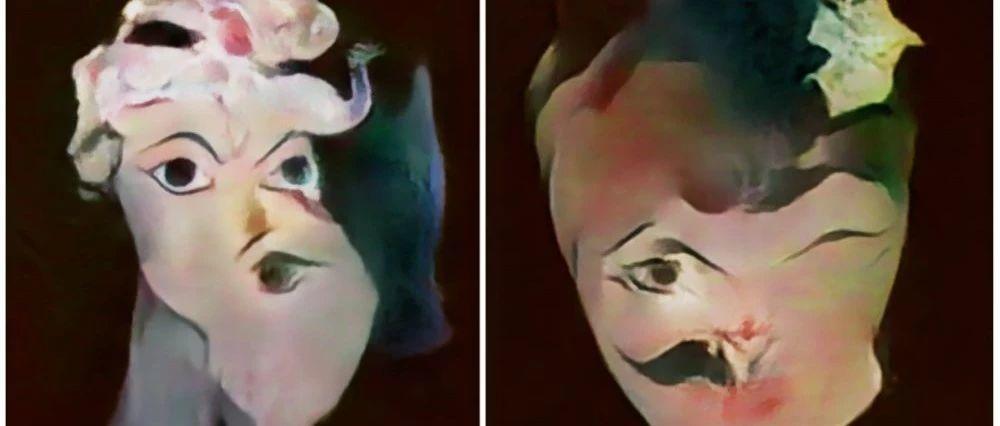
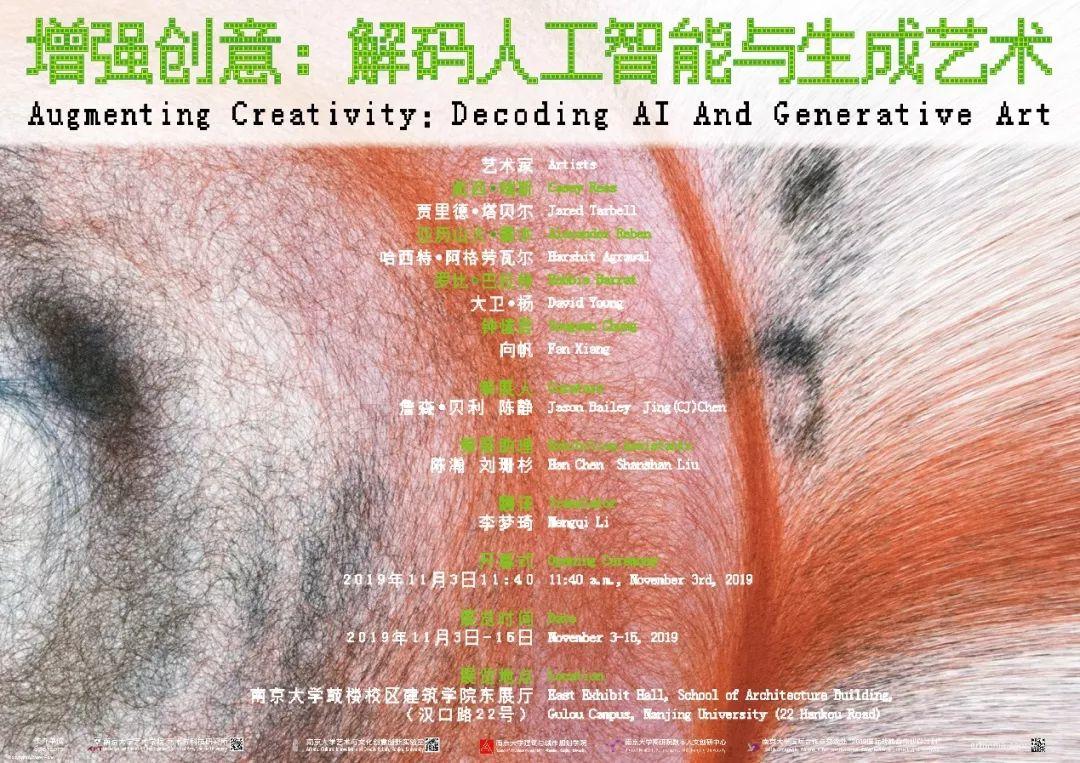
时间:2019年11月3日 11:40
地点:南京大学鼓楼校区建筑学院西展厅105教室(汉口路22号)
主持人:南京大学宣传部副部长 祁林教授
1. 南京大学艺术学院何成洲院长致辞
2. 策展人詹森·贝利致辞
3. 策展人陈静致辞
4. 詹森·贝利主题演讲:我们这一代人中最重要的艺术——生成艺术的历史
5. 策展人导览
我们这一代人中最重要的艺术
——生成艺术的历史
我们如今生活在有史以来发展最快的技术革命中,即数字革命。它改变了世界上的一切——从我们的工作方式到艺术制作方式。詹森·贝利认为生成艺术是我们这一代人中最重要的艺术,因为它反映了随着生活越来越数字化我们所经历的巨大转变。通过历数从1950年到当下的案例,贝利追溯了那些经常被忽视和低估历史里程碑和创新,是他们成就了如此丰富和重要的生成艺术。
The History of Generative Art:The Most Important Art of our Generation
We are currently living during fastest moving technological revolution of all time, the digital revolution. It has changed everything in our world from how we work to how we make art. In this lecture Jason Bailey argues that generative art is the most important art of this generation as it reflects the massive transition we are going through as our lives become increasingly digital. Using examples going back to the late 1950s all the way up to today, bailey traces the key historical milestones and innovations that make generative art so rich and important, though often overlooked and undervalued.
美是难的,柏拉图如是说。理解艺术也是难的,尤其是在数字时代。我们给了人工智能太多不切实际的光环,我们在困惑与误读中将之放入了技术的黑箱。无论是过分地赞誉还是浅薄的指责,其结果都是我们对于数字艺术,尤其是人工智能艺术存在着种种想象与误解,往往少了一份平等视野中的欣赏与理解。
此次展览的目的就是从没有“一种”正确方法的角度来解码人工智能艺术,尤其是通过艺术家自己的观点和看法,来让观众看到:即使是在艺术创作的阶段使用了很多新的数字技术、软件和算法,但艺术家对于技术的态度也是非常多元。
正如策展人詹森•贝利所言,这些艺术家“一些人认为代码和网络无非工具,而另外一些人则视为创意的合作者。每一个艺术家都以其自有的方式探索了如何以技术来增强自身的创造力,创作了个人化的作品,并在展览中创造了一种具有丰富内容的对话”。
What’s beautiful is difficult, as Plato said. Comprehending art is difficult as well, especially in the digital age. Bestowing artificial intelligence too many unrealistic merits, we put it into the black box of technology with confusion and misunderstanding, hence, we hold all kinds of imaginations and misunderstandings towards digital art, especially AI art, whether they be extravagant compliments or perfunctory criticism. What lacks here is unbiased appreciation and comprehension. This exhibition is aiming to decode AI art from the perspective of the artists’ views and opinions to show that there is no ONE correct method to interpret AI art but diverse attitudes to the employment of various digital technologies, software, and algorithms applied in the creation of their artworks. As the curator Jason Bailey says about the artists, “Some see code and networks as just another tool. Others describe it as more of a creative collaborator. That each artist in this show has their way of describing how technology augments their creativity only serves to further individuate their work and brings a richness to the dialogue surrounding the exhibition.”
此次展览展出了目前人工智能艺术领域中生成艺术方面具有代表性的九位艺术家的十部作品,包括凯西·瑞斯(Casey Reas )的两部作品Untitled 5 (Not now. No, no.)与MicroImage (Software 1)、贾里德·塔贝尔(Jared Tarbell)的Substrate、亚历山大·雷本(Alexander Reben)的Latent Faces、哈西特·阿格劳瓦尔(Harshit Agrawal)的Masked Reality、大卫·杨(David Young)的Tabula Rasa、罗比·巴拉特(Robbie Barrat)的Balenciaga AI、钟愫君(Sougwen Chung)的The Limitless The Absolute,以及向帆(Fan Xiang)和朱舜山的两部作品《中国古代家谱视觉化》和《全国美展获奖油画作品视觉化》。尽管他们共享了“艺术家”这个身份,但在技术领域还各有专长,比如凯西·瑞斯除在加州大学洛杉矶分校任教外,还是著名的Processing的共同开发人,其中很多人都是数据可视化、数字设计、人机交互、人机写作、机器人、生成对抗网络方面的技术专家。
这场对话不仅发生在九位艺术家和十部作品之间,也发生在艺术家、艺术作品和观众之间。尽管生成艺术家们在努力平衡艺术创作中的“艺术部分”与编码及机器学习,尽可能的不让观众迷失于技术本身之中,但不得不承认的是,没有一定,哪怕是简单的对计算和代码的认知,观众也是无法真正理解生成艺术作品的。而这一点,恰恰是常常被我们忽略掉了的一点:人工智能艺术并非炫技,亦非单纯的彰显“智能”,而正是以艺术的方式让我们意识到在创造性的问题上,人类是如何得以有新的可能,人类又是如何在一个机器都可以学习的时代获得自身的主体性地位,人类如何用技术来实现新的美、新的艺术。
This exhibition presents ten works by nine representative generative artists in the field of AI art, including Casey Reas’ Untitled 5 (Not now. No, no.) and MicroImage (Software 1), Jared Tarbell’s Substrate, Alexander Reben’s Latent Faces, Harshit Agrawal’s Masked Reality, David Young’s Tabula Rasa, Robbie Barrat’s Balenciaga AI, Sougwen Chung’s The Limitless The Absolute, and Fan Xiang and Shunshan Zhu’s. Herbariums of Ancient Chinese Family Trees and AwardPuzzle. Sharing the same identity as an artist, they respectively have expertise in the field of technology. For instance, Casey Reas is the co-developer of the well-known Processing, in addition to teaching at UCLA. And many of them are technical experts in human-computer interaction, human-computer writing, robotics, and GANs(Generative Adversarial Networks).
The conversation not only takes place among the ten works of the nine artists, but also among the artists, artworks, and audiences. The generative artists try to balance the ‘artistic’ part and coding and machine learning in art creation, to prevent the audience from being distracted from technologies, however, it has to be admitted that the audience cannot truly understand the generative artworks without basic knowledge of computing and code. We have to be aware that AI art is not about showing off fancy technologies, or simply demonstrating what is “intelligence,” but enlightening us as to new possibilities in humans’ creativity, and opening up our thinking to ways human subjectivity can coincide with machines that can learn, and how to use technologies to achieve new beauty and new art.
詹森•贝利是艺术科技领域策展人及评论家。他建造了世界上最大的蓝筹艺术家数据库,用以开展基于艺术的新型数据分析。贝利在艺术与技术方面颇有声誉,曾在佳士得和苏富比(Sotheby’s)以及世界各地的大型艺术博览会上讲解区块链以及人工智能对艺术和艺术市场的影响。他同时还是artnome网站的创始人,运用数据和技术来改善世界艺术史信息,为在历史上受到忽略或者被边缘化的艺术家提供更多机会。
陈静,南京大学艺术学院副教授,从事文化与媒介研究、数字艺术及数字人文研究。近年来主要聚集于数字媒介转型期的视觉知识生产问题,并开展了包括“中国商业广告数据库”、“中国大运河虚拟展示”、“南京非物质文化遗产虚拟展示”及“云锦色彩分析”等在内的一系列数据库项目。
Jason Bailey is a writer and curator covering art and technology for the leading website artnome.com. Bailey built the world’s largest database of complete works by bluechip artists and developed the foundation for a new art-based analytics practice. As a sought-after speaker on the intersection of art and technology, Bailey has lectured on the impact of blockchain and artificial intelligence on art and the art market for Christie’s and Sotheby’s as well as major art fairs around the world.
Jing (CJ) Chen is an associate professor at the School of Arts of Nanjing University. Her research focuses on media studies, digital art, and digital humanities. In recent years, she mainly concentrates on the visual knowledge production during the transformation of digital media, and carries out a series of database projects, including Chinese Commercial Advertisement Archive, Virtual Exhibition of the Grand Canal of China, and Yunjin Brocade Color Analysis.
时间:2019年11月3日-15日
Time: November 3-15, 2019
地点:南京大学鼓楼校区建筑学院东展厅(汉口路22号)
Location: East Exhibit Hall, School of Architecture Building, Gulou Campus, Nanjing University (22 Hankou Road)
主办单位:
南京大学艺术学院 艺术与科技研究所
南京大学艺术与文化创意创新实验室
Artnome.com
南京大学国际合作与交流处“2019国际战略合作伙伴计划”
南京大学高研院数字人文创研中心
南京大学建筑与城市规划学院
Sponsors:
Research Institute of Art and Science, School of Arts, Nanjing University
Art and Cultural Innovation and Creativity Lab, Nanjing University
Artnome.com
“2019 Strategic Partners for International Cooperation”, Nanjing University
Digital Humanities Initiative, IAS, Nanjing University
School of Architecture and Urban Planning, Nanjing University
以下艺术家顺序按照中文姓名首字母排列
The artists are listed in alphabetical order.
哈西特·阿格劳瓦尔
人工智能艺术家,人机交互研究人员
哈西特·阿格劳瓦尔曾在不同地点进行多元文化语境下的驻地艺术实践,包括韩国首尔的纳比艺术中心,巴西·里约热内卢的明日博物馆,日本东京和横滨的笕实验室。在由当代艺术画廊Nature Morte举办的世界最早的AI艺术展之一——《梯度下降》(由64/1策展)中,他是唯一参展的印度艺术家。
阿格劳瓦尔的作品在世界最大的计算机科学博物馆——德国帕德博恩的海因茨·尼克斯多夫博物馆中长期展出。此外,他也在世界其他顶级艺术节和博物馆中展出其作品,包括:奥地利电子艺术节、英国泰特现代美术馆、亚洲文化中心(展览《其他空间/知识》),澳大利亚昆士兰科技大学艺术博物馆(展览《为什么未来仍然需要我们》),巴西明日博物馆、纽约诗学计算学院、韩国纳比艺术中心、法国拉瓦勒虚拟现实展、印度班加罗尔奇妙艺术节和加拿大国际电子艺术研讨会。
艺术家网站:http://harshitagrawal.com/
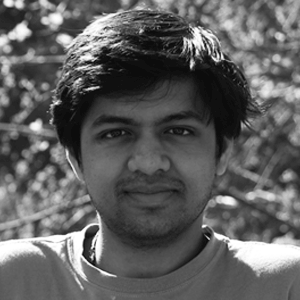
Harshit Agrawal
Harshit Agrawal is an AI (artificial intelligence) artist and human-computer interaction (HCI) researcher.
Harshit Agrawal has carried out art residencies at various places to develop his practice in diverse cultural contexts, including at the Art Center Nabi (Seoul, Korea), Museum of Tomorrow (Rio de Janeiro, Brazil), Kakehi-Lab (Tokyo/-Yokohama, Japan). Agrawal was the only Indian artist in one of the world’s first AI art shows in a contemporary art gallery (Gradient Descent held at Nature Morte gallery, curated by 64/1).
Agrawal’s work is part of the permanent exhibition at the largest computer science museum in the world, the Heinz Nixdorf Museums Forum in Paderborn, Germany. He has been privileged to exhibit his work at other premier art festivals and museums around the world, like the Ars Electronica Festival (Austria), Tate Modern (UK), Asia Culture Center (at Otherly Spaces/Knowledge exhibition curated by Kazunao Abe-san, Korea), QUT Art Museum (Why the Future Still Needs Us exhibition, Australia), Museum of Tomorrow (Brazil), Alt-Ai (at the School For Poetic Computation, NYC), Art Center Nabi (Korea), Laval Virtual (France), BeFantastic Festival (Bangalore, India), ISEA (Canada).
艺术家作品:
《假面现实》
“在我们存在已久的文化中,我们精心设计并参与过众多象征集体和个人转化与超越行为的仪式。在我们进入未知领域时,在我们庆祝人类象征的可锻性时,或者在实际伪装和娱乐中,面具和面部改造装饰品已经成为整个印度文化的基础。
它帮助我们从一个全新的角度与世界互动,增强着我们的自我意识,这与当今的科技(尤其是AI)非常相似。当这些超越性的媒材碰撞在一起的时候会发生什么?我们可以把文化遗产的知识教授给机器,使它们成为我们探索和与遗产互动的工具么?”
Masked Reality
“Throughout our years of existence as a culture, we’ve crafted and performed several kinds of rituals and ceremonies, both collective and individualistic as acts of transformation and transcendence. Masks and face-transformative decorations have been fundamental across the Indian culture in our journeys into unknown realms, in our celebrations of the malleability of human representation, or as a tool for practical disguise and entertainment.
It helps us engage with our world from a completely new vantage point, augmenting our sense of self, very similar to what technology, especially AI, enables today. What happens when these media of transcendence collide? Can we teach machines about our cultural heritage, and as a result, make them an instrument for our own exploration and engagement with our heritage?
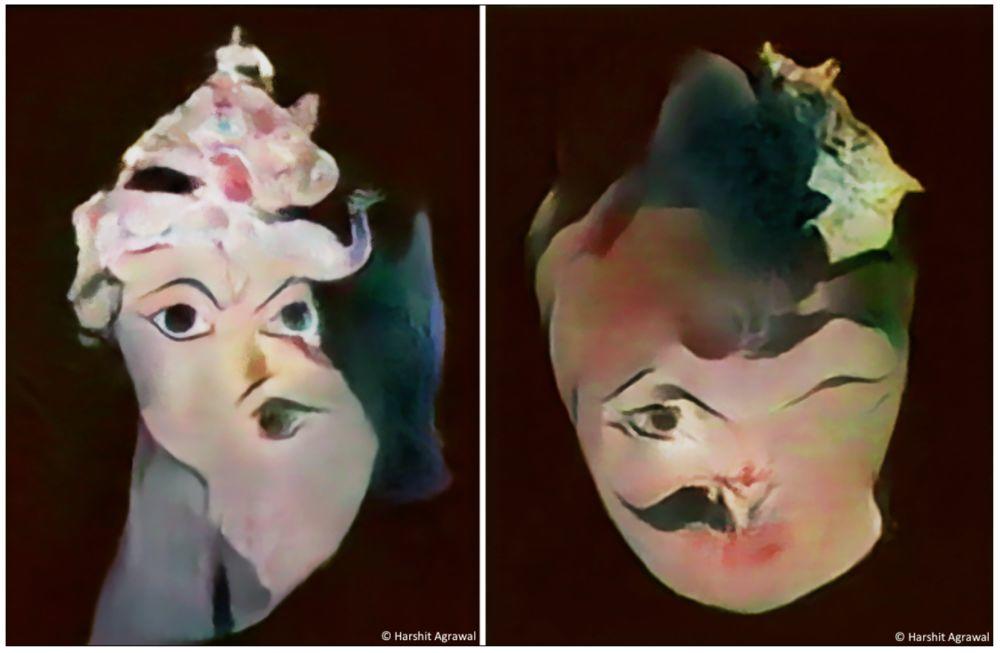
Harshit Agrawal, Masked Reality-2018 http://harshitagrawal.com/works/masked-reality
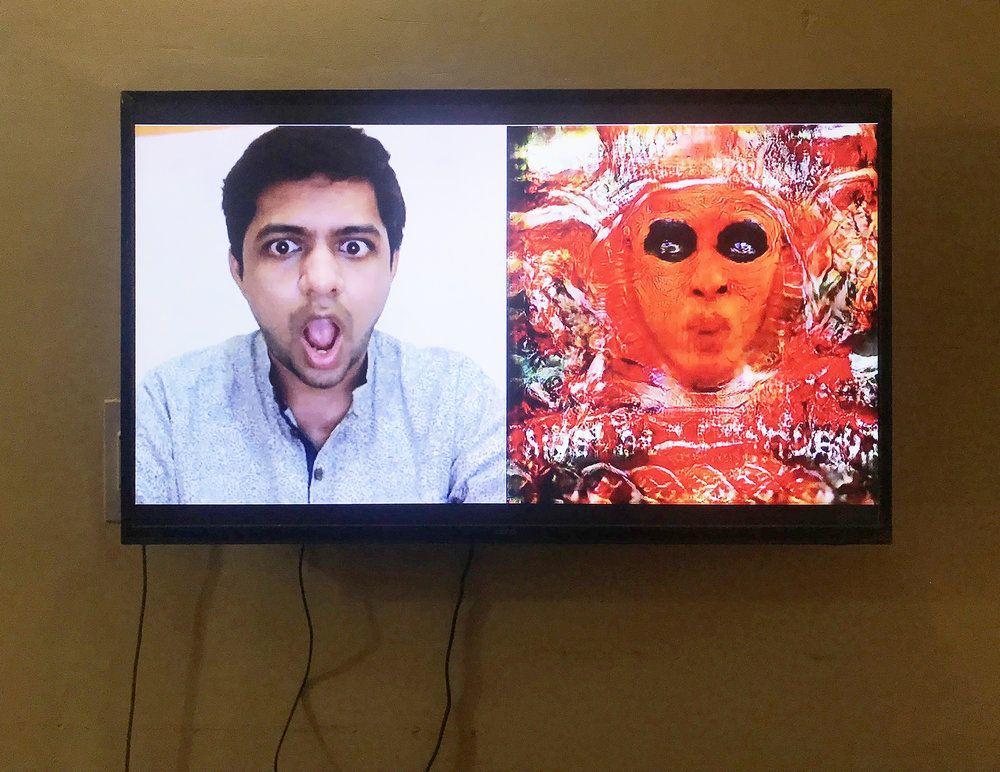
Harshit Agrawal, Masked Reality -2018 http://www.triplecode.com/project/tabularasa.html
2
罗比·巴拉特
作为一名20岁的艺术家,罗比·巴拉特是生成对抗网络艺术中的佼佼者,他创作的超现实裸体和风景作品经常登上新闻头条。他通过操纵神经网络对数据进行误读,从而生成令人惊讶的新奇图像。
他近期参与的展览包括:
个展《巴黎世家神经网络》,时尚博物馆,哈瑟尔特,比利时,2019年10月12日-2020年3月8日;
WPP“流”科技大会,马拉松,希腊,2019年10月16日-19日;
奥地利电子艺术节,林茨,2019年9月5日-9日;
艺术项目《系统故障》,旧金山,2019年5月4日-25日;
Art Jaws作品展,泽克画廊,纽约,2019年5月1日-5日
艺术家网站:https://robbiebarrat.github.io/
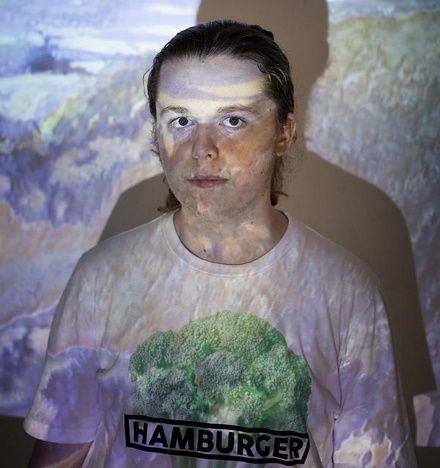
Robbie Barrat
Robbie Barrat is a 20-year-old artist who is a leading light in the world of GAN art, generating headlines with his surreal nudes and landscapes.
Barrat’s work and process revolve around manipulating neural networks to misinterpret data and generate surprising and novel imagery.
Recent exhibitions:
Robbie Barrat, Neural Network Balenciaga, Musée de la Mode, Hasselt, Belgique,12 October 2019-8 March 2020;
STREAM The WPP Unconference, Marathon, Greece, 16 – 19 October 2019;
Ars Electronica, Linz, 5-9 September 2019;
System Failure, San Francisco, 4-25 May 2019;
Art Jaws, Zurcher Gallery, New York, 1-5 May 2019;
艺术家作品:
《巴黎世家AI》
“巴拉特的《巴黎世家AI》是一件精心策划的持续发生对话和实验的作品,模拟设计也是经常如此。轮廓是真实的,但是内部的渐变是诡异的、破碎的,在“人体”模特和衣服之间经常没有一个明确的界限。有时候它以一种怪异的方式完美地体现了秀场上发生的变化,但是有时,在最佳时刻,它呈现了最离奇而有趣的惊喜。AI的结果是很奇怪,也很美。如果你把巴黎世家所有的时装目录扔进一台原子时光机,然后请时光机另外一边的外星人从乱七八糟的残骸中重新构建原物,他们仍然是巴黎世家——另外的平行现实中的巴黎世家——或许是未来的巴黎世家。巴黎世家的创意总监德姆纳,你在听么?”
Balenciaga AI
“Barrat’s Balenciaga AI is a continual work of conversation, experimentation, and curation—just like analog designing so often is. The silhouettes are legitimate, but the gradients are unearthly and fragmented, with often no delineation between where the “human” model stops and the clothing begins. Sometimes it eerily perfects variations of what’s really gone down the runway and sometimes—the best times—it ekes out the most bizarre and joyful spacey surprises. The results of the AI are weird and, yes, beautiful. They are Balenciaga, if you threw all their collections into an atomizing time machine and asked an alien on the other side to reconstruct the originals from the scrambled remains. Alternate-reality Balenciaga. Maybe future Balenciaga. Demna, are you listening?”
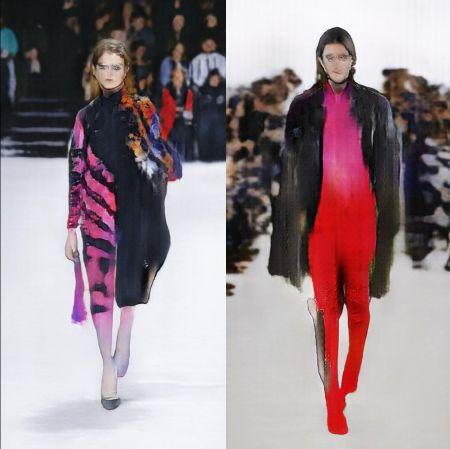
Robbie Barrat, AI Fashion – 2018 https://www.ssense.com/en-us/editorial/fashion/do-androids-dream-of-balenciaga-ss29
3
亚历山大·雷本
艺术家,机器人专家
雷本透过艺术与科技之眼探索人性。他的作品践行着“作为实验的艺术”理念,让观看者在隐喻的语境下体验未来。雷本的艺术作品和研究成果在国际上均有展示与出版。同时,他也为各大公司提供咨询服务,为人机交互环境的未来提供创新指导。
他的作品曾在多处展出,包括:维特拉设计博物馆、维也纳应用艺术博物馆、根特设计博物馆、维也纳双年展、奥地利电子艺术节、VOLTA艺术博览会、翠贝卡电影节、卡姆登国际电影节、Doc/Fest国际纪录片电影节、以及波士顿赛博艺术画廊。
艺术家网站:https://areben.com

Alexander Reben
Alexander Reben is an artist and roboticist who explores humanity through the lens of art and technology.
Using “art as experiment”, his work allows the viewer to experience the future within metaphorical contexts. Reben’s artwork and research have been shown and published internationally, and he consults with major companies, guiding innovation for the social machine future.
He has exhibited at venues including Vitra Design Museum, MAK Museum Vienna, Design Museum Ghent, Vienna Biennale, ARS Electronica, VOLTA, TFI Interactive, IDFA, Tribeca Film Festival, Camden Film Festival, Doc/Fest, and Boston Cyberarts Gallery.
艺术家作品:
《隐藏的面孔》
“我故意设计得很简单,因为作品的理念之一就是,你不需要一个很先进的AI或者复杂的系统就可以碰到很有趣的哲学和伦理问题。”
Latent Faces
“It was kept simple intentionally, as one of the ideas with the work is that you don’t need an advanced AI or complicated system to start encountering interesting philosophical and ethical issues.”

Alexander Reben, Latent Faces https://areben.com
4
向帆
清华⼤大学美术学院视觉传达设计系副教授
她专注于运用数据技术探索文化性、社会性数据中所隐藏的抽象关系,以视觉艺术表现⽽而实现生动的信息传播。主要学术领域集中于:动态媒体设计、数字视觉化设计。她曾经在中国、日本及美国接受设计教育,于美国帕森斯设计学院担任⼈工智能访问教授、⽇本多摩美术大学担任研究员。
向帆最近发表的作品《中国古代家谱视觉化》发现了古代家庭关系中的尚未被普遍观察到的“⼀⼦多父”现象,并构建了跨越千年的巨型家族树。她的作品《全国美展获奖油画作品视觉化》激起了广泛的社会影响,推动了人们对于当代中国艺术评价机制的反思。她的作品及研究成果入选意大利米兰三年展(2019)、法国《1,2,3 Data》数据设计展览(2018)、IEEE视觉化艺术展(2018),中国家设计⼤大展(2012,2019)。近年来她也发表了多篇视觉化设计、设计批评及设计史相关论文。
艺术家网站:https://zeelab.xyz/
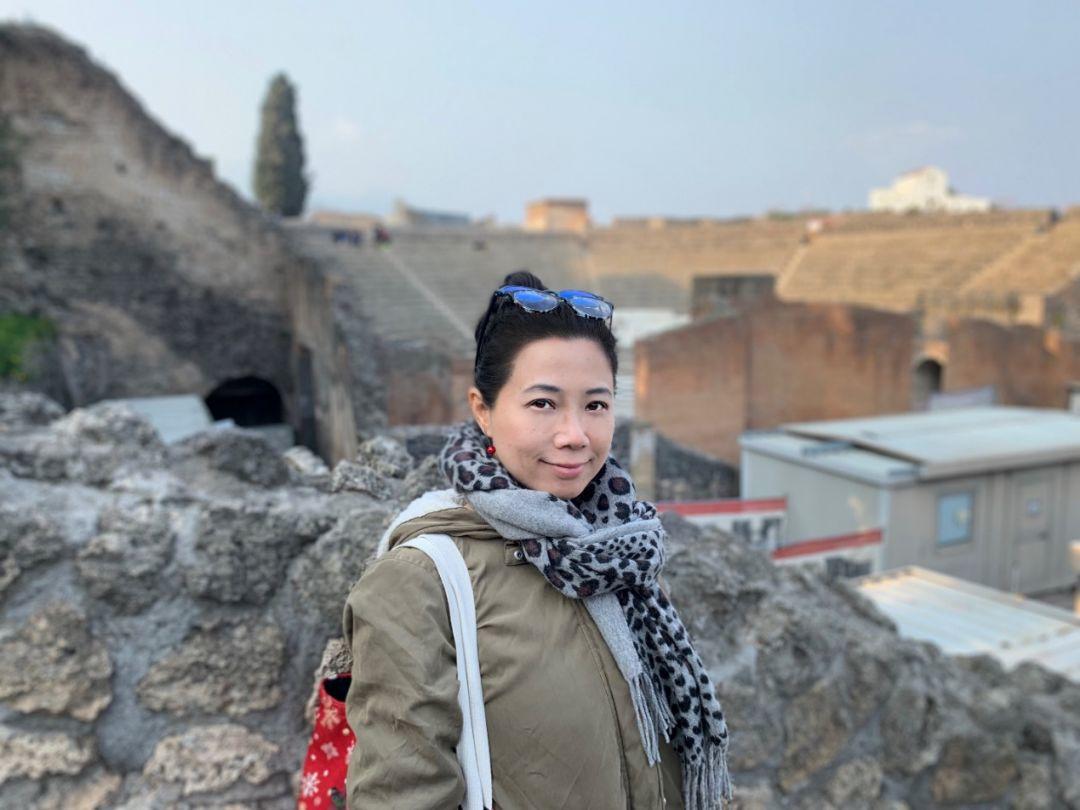
Fan Xiang
Fan is an Associate Professor of the Academy of Art and Design at Tsinghua University. As a designer, artist and educator, her social concerns and critical design thinking have led her practice to the crossroads of visual arts, data visualization, and digital media aesthetics.
She strives to understand the current Chinese culture by visualizing large data from archives. Recently, her works Herbariums of Ancient Chinese Family Trees exhibited in IEEE Visualization 2018 art program, AwardPuzzle was exhibited in Science hosted Data Story competition, as well as international design exhibitions.
Fan’s design education and teaching experiences are from China, the USA, and Japan, and she holds an MFA from the Dynamic Media Institute at Massachusetts College of Art and Design in Boston.
5
朱舜山
计算机科学家
毕业于南理工、中科院和美国麻省大学,具有计算机科学及生物物理学双重学历背景。曾就职于Verizon、BMC 等美国知名通信公司及软件公司,主要知识背景跨越计算机算法、神经网络、互联⽹、⼤数据及数据视觉化。现为北京必果科技创始人兼CTO,主持研发智能语音交互英语教育产品;并在清华大学美术学院智能交互系统设计研究所任高级研究员。
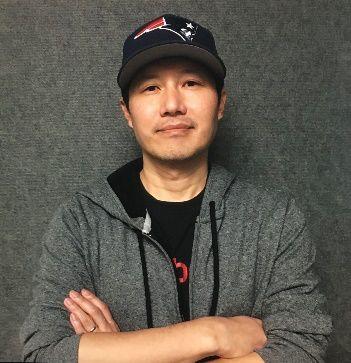
Shunshan (Sam) Zhu
Computer Scientist
Shunshan Zhu has a BA degree in Computer Science and holds two Master’s degrees in Biophysics (Computer Vision, Neural Network) and Computer Science. After being a long -time software architect developing enterprise software in US, he is currently the CTO of a startup company developing an educational application involving NLP, AI, and interactive design. His research interests include Data Visualization, Digital Arts, Digital Humanities and AI.
合作
向帆和朱舜山在数据视觉化、数字媒体及数字艺术领域有大量合作。主要工作是将数据转化为视觉语言,以帮助人们观察抽象关系。作品试图揭示中国当代艺术和艺术教育的状态,并在近年涉猎数字人文领域,不少作品如《全国美展》《央视春晚》等均产生了重要社会影响,并被广泛认同。
他们的作品曾与美国NASA和洛斯拉莫斯国家实验室的作品一起入选美国《科学》杂志“2016数据故事”的最终名单,作品入选2016年和2019年《信息之美》设计大赛长名单,还有作品分别入选2018年法国首次数字艺术展暨巴黎《Data 1, 2, 3》数据设计展、2018年德国柏林IEEE视觉化艺术展、2019年第22界意大利米兰三年展,以及2019年中国国家博物馆《艺术与科学展》。2016年,他们被美国《快公司》中文版评选为年度中国商业最具创意100人。
Collaboration
Fan Xiang and Shunshan Zhu’s visualization work AwardPuzzle were selected in the first France digital art exhibition Data 1,2,3 in Paris in 2018, and the final list of 2016 Science Magazine Data Story Video Competition along with the works from NASA and LANL. Their another work Herbariums of Ancient Chinese Family Trees were exhibited in International Arts and Science Exhibition in China National Museum in Beijing in 2019, in 22th Milano Triennale in Milan in 2019, and in IEEE Visualization Art Program in Berlin in 2018. They were both selected as 100 Most Creative Persons in Business by FastCompany Chinese version in 2016.
两位艺术家合作作品:
《中国古代家谱视觉化》
“中国历代人物传记资料库(简称CBDB)做了一件很有意义的事情,几十年以来它收集了无数重要的数据。但是当我们去深挖的时候,就会发现一些问题,比如出生日期、死亡日期还有籍贯信息的缺失。就是在兄弟姊妹之间,有时候也找不到关于他们某一个特定祖先的数据。有时候,数据库里面还会有一些明显矛盾的信息,比如一个人拥有不止一个特定的祖先,或者更荒谬的——父亲的出生日期晚于其子女。有时候我们通过定位一些分散的数据了解到一个人是另外一个人的第五代后人,但是中间却没有亲戚。”
Herbariums of Ancient Chinese Family Trees
“China Biographical Database (CBDB) did a wonderful job collecting as much valuable data as possible over many decades. When we carefully dig into it, we found we were facing some problems such as there were missing birth dates, death dates, and hometowns. Even among siblings there were sometimes missing data about relationships with a certain ancestor. In other cases, the database has obvious conflicting evidence, where one person has more than one kind of a particular ancestor, or more absurdly where a father has birth date later than his child. Sometimes we located scattered data where we knew one person is another person’s 5th generation descendant but there were no relatives in between.”
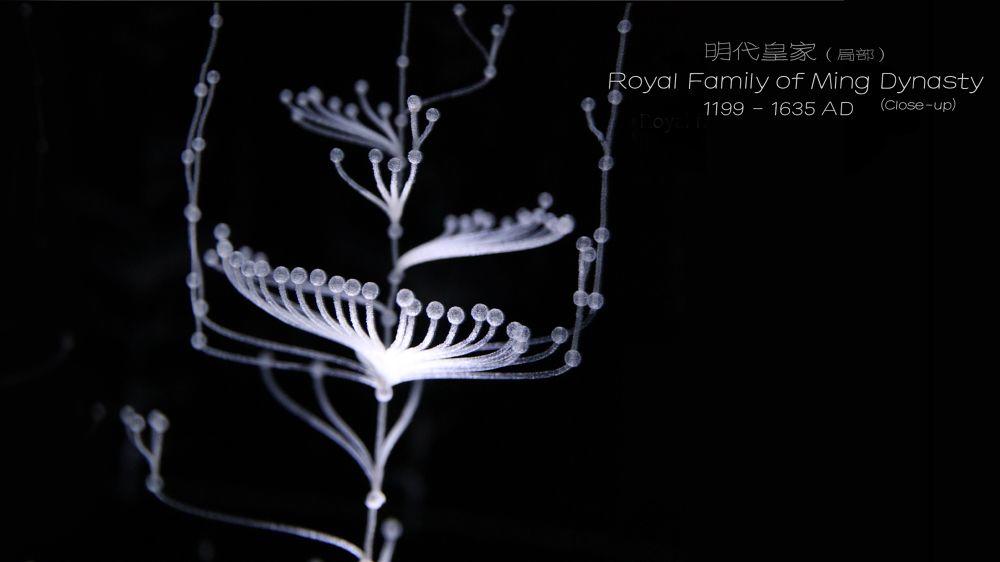
Fan Xiang, Shunshan Zhu, Herbariums of Ancient Chinese Family Trees https://www.zeelab.xyz/Ancient-Family-Tree-Am-I-a-Descendant-of-a-Royal-Family
《全国美展获奖油画作品视觉化》
“《全国美展获奖油画作品视觉化》是一个互动的数据可视化在线平台,这里对第6届到第12届2276幅全国美展油画奖提名作品进行了可视化呈现,旨在尝试用中国顶级艺术家的作品,以多种动态互动的方式描绘中国油画30年的历史。该作品用多种形式的分布图来揭示中国主要国家艺术奖项评审团的偏好,并为如何获得此奖项,以及如何保持三十多年的获奖记录提供“建议”。”
AwardPuzzle
“AwardPuzzle is an interactive data visualization online platform to visualize 2276 oil painting works awarded in 6th through 12th China National Exhibition of Fine Arts. The project tries to paint a picture of 30-year Chinese oil painting history in multiple ways of dynamic interactions using the works from top-level artists of China. AwardPuzzle uses diversified forms of mapping to reveal the preferences of the juries of China’s major national arts awards, and in doing so provides “tips” on how to win such awards and how to keep winning for more than thirty years.”
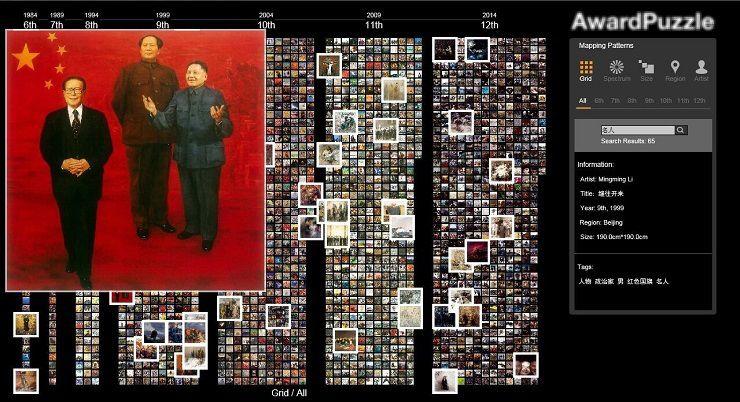
Fan Xiang, Shunshan Zhu, AwardPuzzle https://www.zeelab.xyz/AwardPuzzle
6
凯西·瑞斯
(1972年生于美国俄亥俄州)
加州大学洛杉矶分校教授
现工作生活于洛杉矶。
2011年他和本·弗莱共同开发了开源编程语言Processing (一款为视觉艺术打造的开源编程语言环境系统)。他的作品小到纸上作品,大到城市公共装置。在工作室创作个人作品的同时,他与诸多建筑师和音乐家也均有合作。
瑞斯的软件作品、印刷作品和艺术装置作品曾在美国、欧洲和亚洲的多家美术馆与画廊中展出,并被纳入一系列私人和公共收藏,收藏机构包括蓬皮杜艺术中心和旧金山现代艺术博物馆等。
艺术家网站:http://reas.com/
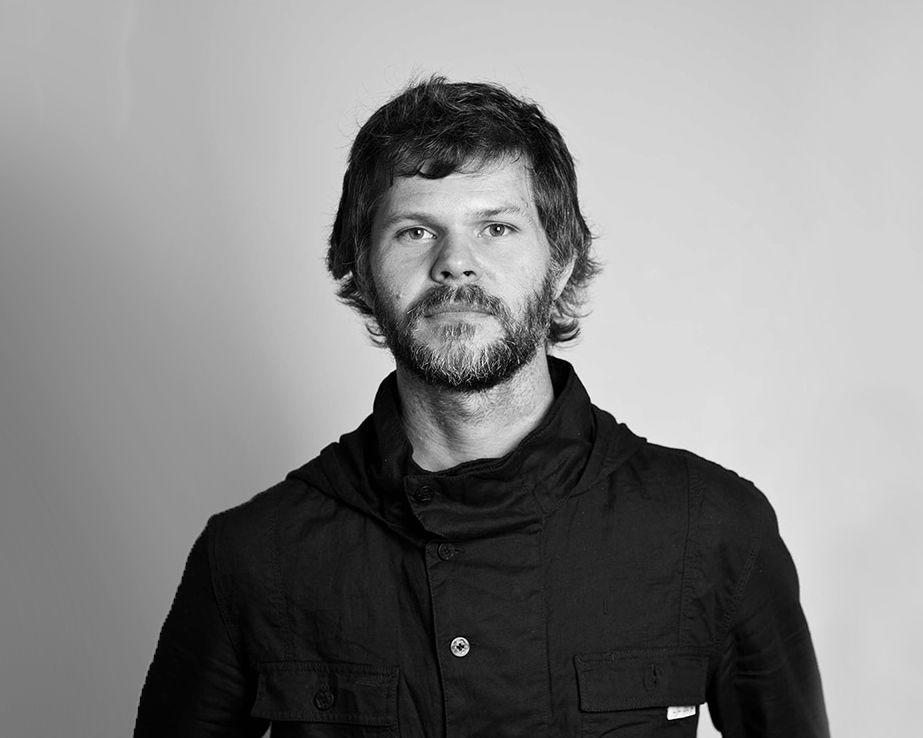
Casey Reas
(b. Ohio, US, 1975)
Lives and works in Los Angeles.
Reas is a professor at the University of California, Los Angeles. With Ben Fry, Reas created Processing (an open-source programming language and environment for the visual arts) in 2001. His work ranges from small works on paper to urban-scale installations, and he balances solo work in the studio with collaborations with architects and musicians.
Reas’ software, prints, and installations have been featured in numerous solo and group exhibitions at museums and galleries in the United States, Europe, and Asia. Reas’ work is in a range of private and public collections, including the Centre Georges Pompidou and the San Francisco Museum of Modern Art.
艺术家作品:
《微像》(软件1)
“软件《微像》的核心算法是一天之内写成的。该软件目前这一版是逐步迭代开发而来的。虽然控制运动的基本算法是理性构建的,随后的发展却是多个月以来和软件互动后美学判断的结果。通过直接操控代码可以创建成百上千个快速迭代,并在分析响应结构的基础上进行调整。整个过程更像是跟随直觉绘制的草图而非理性的计算。”
MicroImage (Software 1)
“The core of the ‘MicroImage’ software was written in one day. The current version of the software has developed through a gradual evolution. While the base algorithm controlling the movement was constructed in a rational way, subsequent developments were the result of aesthetic judgments constructed through many months of interacting with the software. Through directly manipulating the code, hundreds of quick iterations were created, and changes were implemented based on analyzing the responsive structures. This process was more similar to intuitive sketching than rational calculation.”
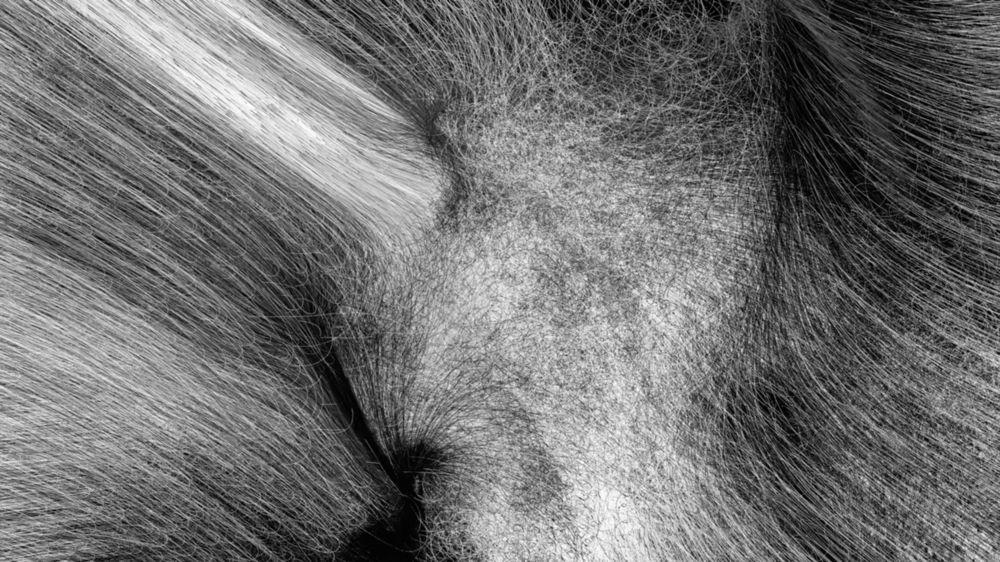
Casey Reas, Still from Microimage (Software 1) – 2002/2014 http://reas.com/microimage_s1/
《无题5(不是现在。不,不)》
每一部《无题》影片都是一个想象的空间,暴露着我对清晰与转瞬即逝之间的梦境般图像的渴望。
GAN(生成性对抗网络)的明确研究目标是创造与摄影图像没有差别的图像,但是《无题》系列的影片则旨在利用GAN创造未知的景观。
Untitled 5 (Not now. No, no.)
Each Untitled film is an imagined space that exposes my desires for ambiguous, dreamlike images that oscillate between clarity and the ephemeral. The explicit research goal of GANs is to create images that are indistinguishable from photographic images, but the aim for the Untitled films is to work with GANs to create unknown landscapes.
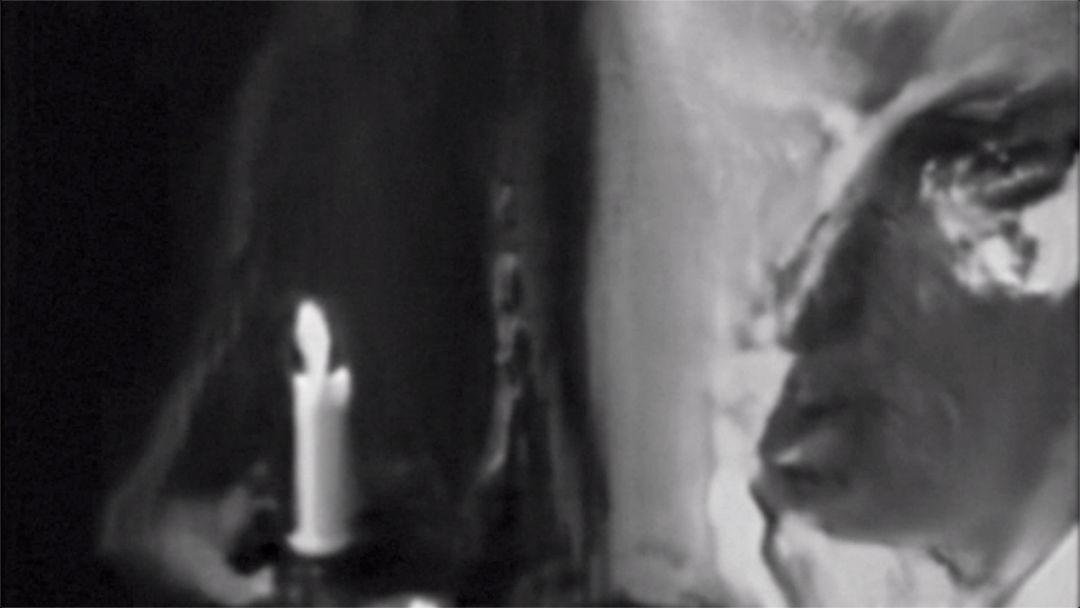
Casey Reas, Still from Untitled 5 (Not now. No, no.), photo credits to the artist
7
贾里德·塔贝尔
(1973年生于美国新墨西哥州)
计算机编程师
塔贝尔喜欢将生成设计融入图形艺术。2005年7月,他参与共同创立了Etsy(全球手工制品售卖市场)。最近他创建了一家玩具工厂,将算法设计带入了材料世界。
艺术家网站:
http://www.complexification.net/programmer.htm

Jared Tarbell
(b. New Mexico, US, 1973)
Tarbell is a computer programmer interested in the intersection of graphic arts and generative design. In July 2005, Jared co-founded Etsy, the global marketplace to buy and sell handmade goods. More recently he built a toy factory to bring algorithmic design into the material world.
艺术家作品:
《基层》
“让我们想象一下在这个系统里面,我们创建一根线条然后让这根线条去任意绘制。这条线在碰到屏幕边缘或另一条线之前都会一直绘制下去,停下来的时候两条新的线就形成了。新的线也只有在与现有线成直角的时候才会生成。这就是所有的规则。但是当我们一直重复这个过程的时候,一些神奇的事情就发生了,我就放任它进行下去。”
Substrate
“Let’s imagine in this system that we create a line and we allow this line to draw. The line will continue to draw until it hits the edge of the screen or another line and then it stops and then two new lines form. New lines will also only form at right angles to existing lines. So those are the rules. But if we repeat this process over and over again, something amazing happens, so I am just going to let this go.

Jared Tarbell, Substrate – 2003 http://www.complexification.net/gallery/machines/substrate/index.php
8
大卫·杨
现工作生活于纽约布鲁克林和加州洛杉矶。
大卫·杨的整个职业生涯都在新兴技术的前沿领域探索。他现阶段的作品探讨了美感和审美体验如何为我们对于新技术的思考提供新起点。
他开创了一家尖端设计工作室,同时也为其他设计机构工作,并提供个人咨询服务。他曾担任美国平面设计协会洛杉矶区域的董事会成员,并在纽约新学院的设计艺术中心学院和帕森斯设计学院任教。他的设计作品获得了众多媒体的认可并获得诸多奖项,其中包括美国商业周刊和美国工业设计师协会颁发的金奖。
艺术家网站:http://www.triplecode.com/

David Young
David is based in Brooklyn, NY and Los Angeles, CA.
David Young has spent his entire career at the leading edge of emerging technologies. His current work explores how beauty and aesthetic experiences can give a fresh start to how we think about new technologies.
Over the course of his career, he founded a cutting-edge design studio, worked for design agencies, worked in-house, and independently consulted. He has served on the board of AIGA/LA and taught at both Art Center College of Design and Parsons at The New School. His design work has been recognized with a wide range of press and awards — including a Gold Medal from Businessweek & IDSA.
艺术家作品
《感觉板》
“像AI的编程人员一样,使用AI的艺术家并不去制定规则,而是训练网络。最后呈现的艺术作品的外观和体验都和以往基于计算机的艺术形式有所不同,因为他们所反映了庞大而神秘莫测的神经网络中的有机混乱。“
“我们是否需要发展一种新的美的概念来评估使用这些系统出现的结果?一种新的美学是否能让我们对于人工智能有一个更好更全面的理解呢?“
“鉴于我们不得不使用人类的术语来描述AI系统的行为——我们说机器在“学习”,它“知道”某些东西,它具有“技能”,“智能”一词是不可避免的——或许我们应该寻找下其他的人类特征。机器的“情感”可能成为我们接触和理解AI的新方式么?”
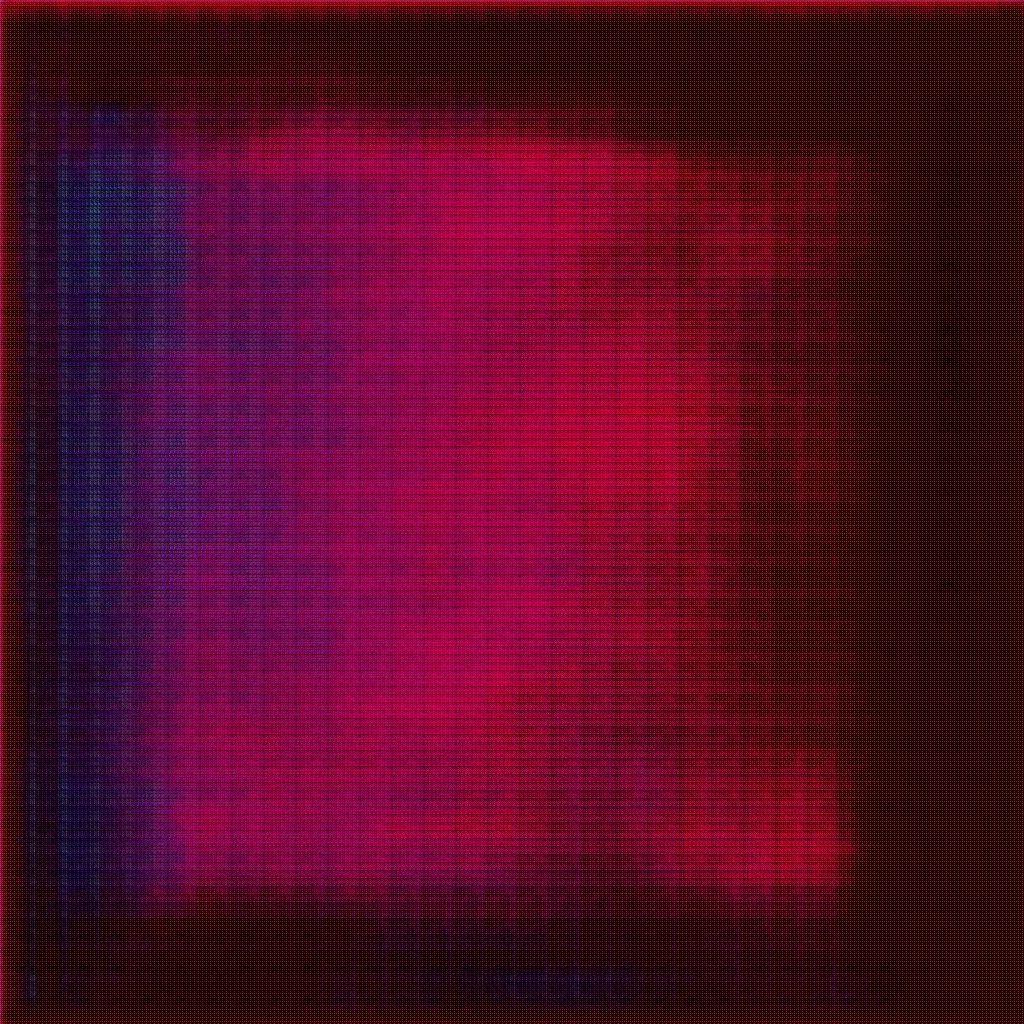
David Young, Tabula Rasa http://www.triplecode.com/project/tabularasa.html
Tabula Rasa
“Like AI programmers, artists working with AI don’t encode rules, but instead train networks. The resulting artworks look and feel different from previous forms of computer-based art for they reflect the organic messiness of their vast and inscrutable neural networks.”
“Do we need to develop a new concept of beauty to evaluate what emerges from working with these systems? And is it possible that a new aesthetic can give us a better, more empowered understanding of AI?”
“Given that we can’t help but use human terms to describe the behavior of AI systems — we say that the machine is ‘learning,’ it ‘knows’ something, it has ‘skills,’ the word ‘intelligence’ is inescapable — perhaps we should look for other human traits. Might machine ‘emotions’ be a new way for us to approach and understand AI?”
9
钟愫君
加拿大华裔艺术家
现居于纽约。
钟的作品探讨了如何以人工打标和机器打标来理解人类和系统的动力学。她曾是麻省理工学院媒体实验室的研究员,也是人机协作领域的先驱。2019年她因在艺术于科学领域的成就获得“蒙特卡洛年度女性奖”。
她的作品在全球都有广泛展出,展出场所包括:迈阿密巴塞尔艺术展、东京国立艺术中心、东京国际交流中心、新加坡艺术科学博物馆、麻省理工学院媒体实验室、纽约素描中心、纽约新当代艺术博物馆(天空厅)、日内瓦当代艺术博物馆、纽约马纳当代艺术中心、纽约翠贝卡电影节、伦敦医院俱乐部、蒙特利尔&墨西哥MUTEK电子音乐节、巴塞罗那声纳音乐节。
艺术家网站:https://sougwen.com/

Sougwen Chung
Sougwen Chung is a Chinese-Canadian artist and (re)searcher based in New York.
Chung’s work explores the mark-made-by-hand and the mark-made-by-machine as an approach to understanding the dynamics of humans and systems. Chung is a former research fellow at MIT’s Media Lab and a pioneer in the field of human-machine collaboration. In 2019, she was selected as the Woman of the Year in Monaco for Achievement in the Arts & Sciences.
Her work has been exhibited internationally, including at Art Basel, Miami; National Art Center, Tokyo; NTT InterCommunication Center [ICC], Tokyo, Japan; ArtScience Museum, Singapore; MIT Media Lab, Cambridge; The Drawing Center, New York; The New Museum (Sky Room), New York; Museum of Contemporary Art, Geneva; Mana Contemporary, New York, Tribeca Film Festival, New York; The Hospital Club, London; Mutek Festival, Montreal & Mexico City; Sonar Festival, Barcelona.
《无极、太极》
“我并不认为传统和科技是对立的或者相互排斥的。我使用传统技术,但是难道我们不应该把科技的应用当成一种惯例么?目前我们既可以围绕手工制造展开传统叙事,也可以围绕机械制造展开技术叙事,而我正在做的无疑是对两者交汇处可能性的探索…这条探索之路越走越清晰。”
“在《无极、太极》里,钟愫君艺术性地诠释了“八卦”;道家的八卦把现实世界看作是鲜活的、充满感情的经验性环境。道家宇宙观的八卦概念解释并且思考了现实和存在。艺术家运用八卦图案的概念性逻辑创造了精致、复杂、不断变化的环境,表现了生态系统。”
“I don’t see tradition and technology as oppositional or mutually exclusive. I utilize the technology of tradition, and are we not growing into a tradition of technology? Insofar as we can frame a narrative around tradition as that which is made by hand and technology as that which is made by machine, the work I’m doing is certainly an exploration of the possibilities in the intersection of both… one that is gaining clarity the further along I go.”
“‘The Limitless, The Absolute’ is an artistic interpretation of the Bagua八卦; the eight Taoist trigrams that represent the principles of reality as organic, emotive, and experiential environments. The correspondences between the eight interlocking concepts of the Bagua are used in Taoist cosmology to interpret and contemplate reality and existence. The patterns formed as the trigrams interrelate provide the conceptual logics used by the artist to create delicate, complex, shifting environments resembling ecosystems.”

Sougwen Chung, The Limitless, The Absolute -2017
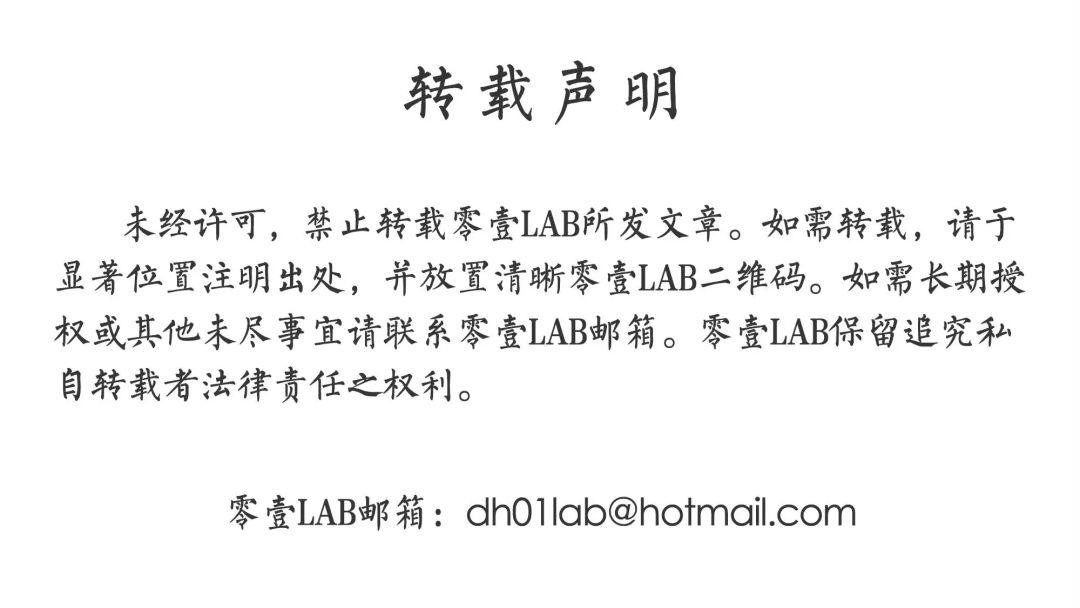
END
主编 / 陈静
责编 / 刘双双
美编 / 刘双双
原文始发于微信公众号(零壹Lab):展览信息丨增强创意:解码人工智能与生成艺术